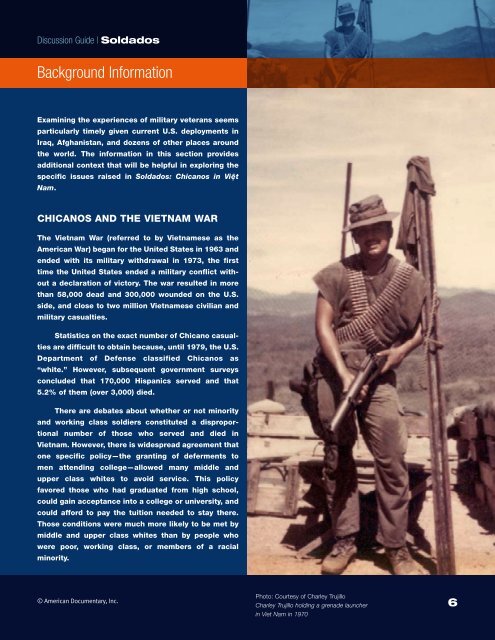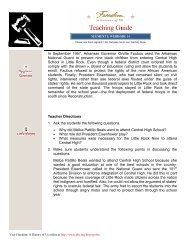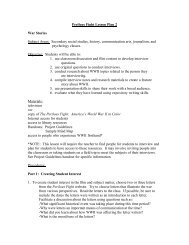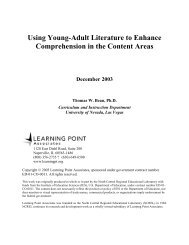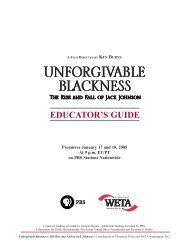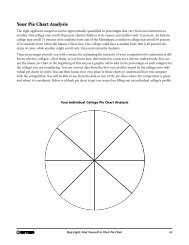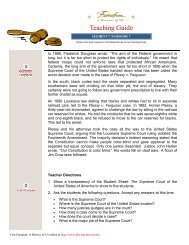Soldados: Chicanos in Viê. t Nam - PBS
Soldados: Chicanos in Viê. t Nam - PBS
Soldados: Chicanos in Viê. t Nam - PBS
Create successful ePaper yourself
Turn your PDF publications into a flip-book with our unique Google optimized e-Paper software.
Discussion Guide | <strong>Soldados</strong><br />
Background Information<br />
Exam<strong>in</strong><strong>in</strong>g the experiences of military veterans seems<br />
particularly timely given current U.S. deployments <strong>in</strong><br />
Iraq, Afghanistan, and dozens of other places around<br />
the world. The <strong>in</strong>formation <strong>in</strong> this section provides<br />
additional context that will be helpful <strong>in</strong> explor<strong>in</strong>g the<br />
specific issues raised <strong>in</strong> <strong>Soldados</strong>: <strong>Chicanos</strong> <strong>in</strong> <strong>Viê</strong>. t<br />
<strong>Nam</strong>.<br />
CHICANOS AND THE VIETNAM WAR<br />
The Vietnam War (referred to by Vietnamese as the<br />
American War) began for the United States <strong>in</strong> 1963 and<br />
ended with its military withdrawal <strong>in</strong> 1973, the first<br />
time the United States ended a military conflict without<br />
a declaration of victory. The war resulted <strong>in</strong> more<br />
than 58,000 dead and 300,000 wounded on the U.S.<br />
side, and close to two million Vietnamese civilian and<br />
military casualties.<br />
Statistics on the exact number of Chicano casualties<br />
are difficult to obta<strong>in</strong> because, until 1979, the U.S.<br />
Department of Defense classified <strong>Chicanos</strong> as<br />
“white.” However, subsequent government surveys<br />
concluded that 170,000 Hispanics served and that<br />
5.2% of them (over 3,000) died.<br />
There are debates about whether or not m<strong>in</strong>ority<br />
and work<strong>in</strong>g class soldiers constituted a disproportional<br />
number of those who served and died <strong>in</strong><br />
Vietnam. However, there is widespread agreement that<br />
one specific policy—the grant<strong>in</strong>g of deferments to<br />
men attend<strong>in</strong>g college—allowed many middle and<br />
upper class whites to avoid service. This policy<br />
favored those who had graduated from high school,<br />
could ga<strong>in</strong> acceptance <strong>in</strong>to a college or university, and<br />
could afford to pay the tuition needed to stay there.<br />
Those conditions were much more likely to be met by<br />
middle and upper class whites than by people who<br />
were poor, work<strong>in</strong>g class, or members of a racial<br />
m<strong>in</strong>ority.<br />
© American Documentary, Inc.<br />
Photo: Courtesy of Charley Trujillo<br />
Charley Trujillo hold<strong>in</strong>g a grenade launcher<br />
<strong>in</strong> Viet <strong>Nam</strong> <strong>in</strong> 1970<br />
6


